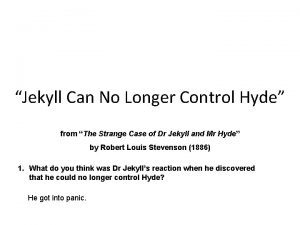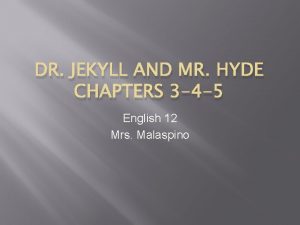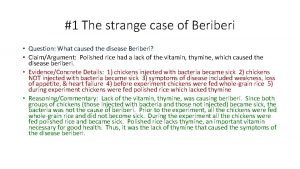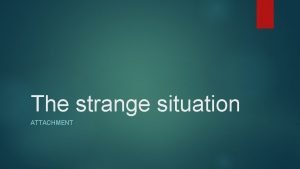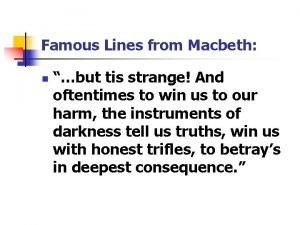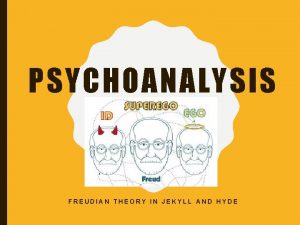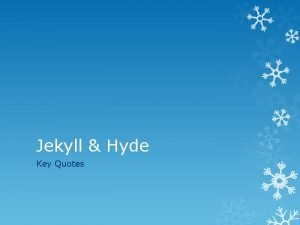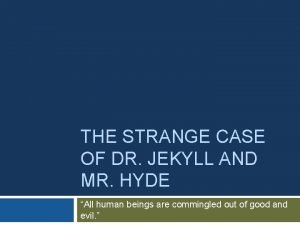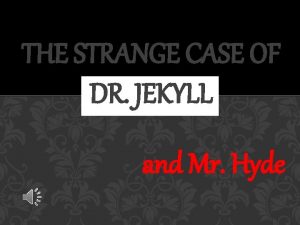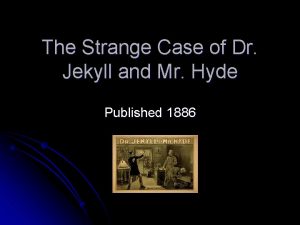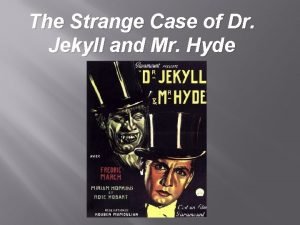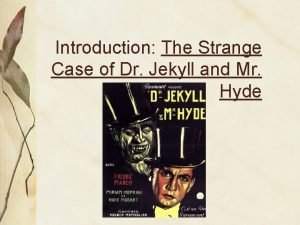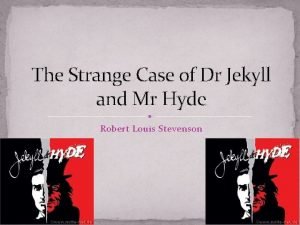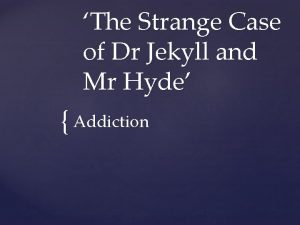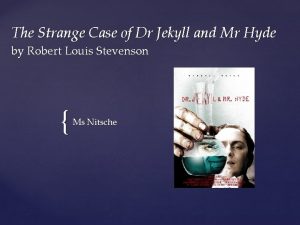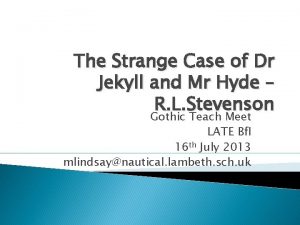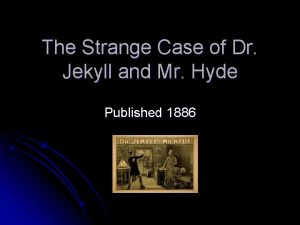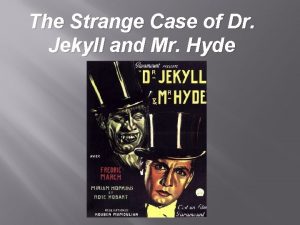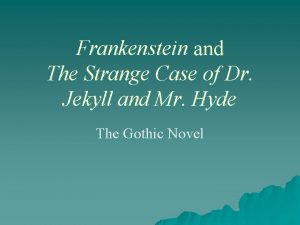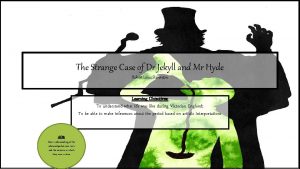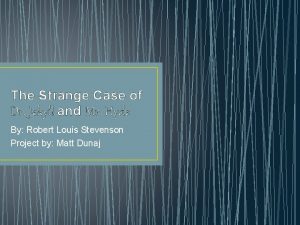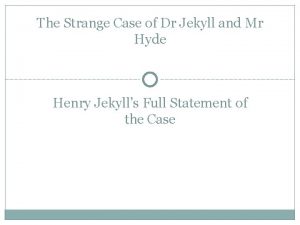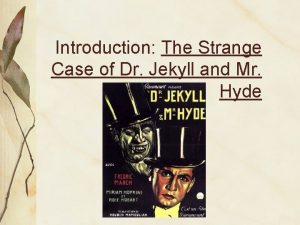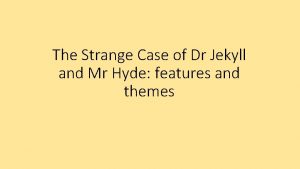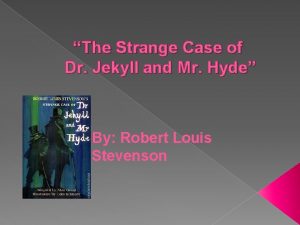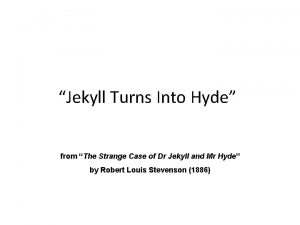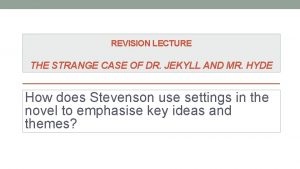The Strange Case of Dr Jekyll and Mr






















- Slides: 22

The Strange Case of Dr Jekyll and Mr Hyde Exam Revision

Aims n To revisit key areas of the text. n To highlight important areas for revision. n To examine potential questions and prepare for a timed essay (tomorrow).

Important episodes of the novel to learn (if you haven’t already!). Intriguing opening: we are alerted to themes of secrecy. Powerful symbolism is made apparent when we are introduced to the door. n Also introduced to Utterson. Can be compared with Jekyll as a man with dual nature. ‘Something eminently human beaconed from his eye’. ‘Drank gin when he was alone’. Alcoholism is hinted at on more than one occasion with U – theme of addiction, which is central in the novel. n Also references to setting and the appearance of Hyde. n Symbolism of the door, too, which immediately introduces us to secrecy. n

Story of the Door n n Something displeasing, something down right detestable. I never saw a man I so disliked, and yet I scarce know why. He must be deformed somewhere…although I couldn’t specify the point. ’ There is something intrinsically wrong with Hyde. His evil represents the evil within us all that we don’t mention. That which we keep hidden from public eyes. Utterson and Jekyll both have this quality. You can use his quote to analyse: secrecy, addiction, duality, compare J and U, explore Hyde’s character. Very useful to know as can be used for a multitude of questions.

Search for Mr Hyde n Setting: ‘The lamps, unshaken by any wind, drawing a regular pattern of light and shadow. ’ n Hyde’s animalistic tendencies: ‘ A sharp intake of the breath. ’ ‘Snarled aloud in a savage laugh. ’ n ‘If I ever read Satan’s signature on a face, it is on that of your new friend. ’

Dr Jekyll Was Quite At Ease n Description of Jekyll: ‘slyish cast’. J is hiding something. n Addiction: ‘the moment I choose, I can be rid of Mr Hyde. ’ Comment carries the hallmark of addiction, a certain misplaced sense of control.

The Carew Murder Case n Key development in plot. A savage and most violent attack that is used to show the dark capabilities of man if we act without a sense of morality or conscience. This, essentially, is why Hyde has been created, to avoid a sense of guilt. This is a rather despicable act and presents J as rather self-centred. Therefore, Stevenson is perhaps warning us against science being used for our own ends – hubris and an arrogance in playing God.

Addiction: novel warns of the dangers. Specifically alcohol and drug abuse. Events such as this serve to show the suffering that one causes. n Duality: shown through setting. Key quote to discuss London/ Soho in terms of setting. Can be connected to character. n The capabilities of Hyde: savage and violent language used – ‘incredibly mangled’. n

Incident of the Letter Laboratory: secrecy tied in with setting. You can easily link anything to do with secrecy to the idea of reputation. n Signs of addiction: ‘held out a cold hand bade him welcome in a changed voice’. ‘It is all at an end…he is safe, he is quite safe; mark my words, he will never more be heard of. ’ n Reputation: ‘I was thinking of my own character, which this hateful business has rather exposed. ’ Link with earlier quote, ‘one of your fellows who do what you call good. ’ We hide our true self? n n

n Utterson as an addict: seeking solace from the fogs of London with his alcoholism – ‘insensibly the lawyer melted’. Sensual language shows the appeal of succumbing to our vices – ‘the imperial dye had softened with time, as the colour grows richer in stained windows; and the glow of hot autumn afternoons on hillside vineyards, was ready to be set free and disperse the fogs of London. ’

Remarkable Incident of Doctor Lanyon n Lanyon’s death and the dangers of knowledge: ‘ I sometimes think if we knew all, we would be more glad to get away. ’ Explores the dangers of science and a warning against hubris. n Lanyon’s letter: ‘the packet slept in the inmost corner of his private safe. ’ Stevenson creates suspense and develops theme of secrecy.

Incident at the Window Crisis point/ complication: Jekyll can no longer control his addiction. An involuntary change comes across his countenance. ‘ the words were hardly uttered, before the smile was struck out of his face and succeeded by an expression of such abject terror and despair, as froze the blood of the two gentlemen below. ’ n Use to develop J’s character and to show a point in the narrative where we are deeply concerned for the wellbeing of J, yet are equally intrigued to find out what exactly is going on. Once more Stevenson creates suspense and mystery. n

The Last Night n Setting: pathetic fallacy used to suggest aggression and create tension. Building up to climax. n Hyde’s mask and animalistic descriptions. n Link in reputation – J must hide away as he has a malady that ‘both torture[s] and deform[s] the sufferer. ’ Syphilis/Onanism.

n Climax of the novel: auditory imagery as well as the use of synaesthesia to create a sense of duality and contrast. Violence vs. peace. Noise vs. silence. Also see use of sentence structure. n Arguably, we have a sense of anti-climax as we are not presented with the answers we deeply desire.

Doctor Lanyon’s Narrative Stevenson using epistolary form (letters) to develop a non-linear narrative, which sustains mystery and suspense until the end. n The effect of Hyde: On viewing Hyde, Lanyon attributes his distaste to something quite profound. ‘I have since had reason to believe the cause to lie much deeper in the nature of man, and to turn on some nobler hinge than the principle of hatred. ’ Hyde represents the worst in all of us, our deep-rooted, dark desires. Furthers the idea that the novel makes a comment on the duality of man. n Questions become answered – J is also H!!! n

Henry Jekyll’s Full Statement of the Case n n Notice change in narrative style in final 2 chapters. We are allowed a direct insight into the minds (albeit in epistolary form) of Lanyon and Jekyll. It is here that the mystery and secrecy that shrouds the novel begins to be truly lifted. ‘Committed to a profound duplicity of life’, ‘that man is not truly one, but truly two. ’ J’s intentions: ‘ the unjust might go his way, delivered from the aspirations and remorse of his more upright twin. ’ A noble creation? Or a selfish one, designed so that J my indulge his darker side? J wants to alter ‘the very fortress of identity’. The enormity of his task and also the dangers; he meddles with what he aught not to – science and hubris.

n n Plenty on addiction in this chapter, including slavery quote. Deep connection show between Jekyll and Hyde through S’s use of structure: ‘Jekyll had more than a father’s interest; Hyde had more than a son’s indifference. ’ Antithesis used here to show the marked difference between the two, yet also the parallel structure interestingly marks their deep connection. ‘My devil had long been caged, he came out roaring. ’ warns of dangers of suppressing our true nature.

Choose a novel which explores the cruelty of human nature. Show the writer explores this theme and discuss how its exploration enhances your appreciation. n n n We have 2 sides, novel explores that we have dark and light and that there is a struggle. Description of Hyde as embodiment of evil in all of us. Carew’s murder Novel explores idea that there is a constant struggle in all of us – setting. We can be cruel to ourselves – succumbing to addiction/climax of novel and suicide.

Choose a novel in which the fate of a main character in important in conveying a theme. Explain what you consider theme to be and discuss how effectively the fate conveys it. n n n Key theme here is addiction and hiding it. Obviously still mention duality as this can be used to explore the conflict within. Mention suicide as J succumbs to addiction – warning of the dangers of addiction. J’s language carries the hallmarks of an addict and this gets worse as the novel progresses. Language of slavery that permeates the ‘Statement…’ used here as well. Dangers seen in other characters, too. Utterson, for example. Addiction seen as an internal struggle that one must keep secret – developed through symbolism and setting (war-like imagery). Overall, novel warns us of the dangers of addiction and vice. Suicide at the novel’s climax is a tragic yet most apt way of conveying this.

Choose a novel in which a character faces a crisis point. Explain how this point is reached and discuss how response extends understanding of him. n n n Crisis = when J can no longer control H. Response is a downward spiral leading to suicide. Explore addiction – dangers of. We sympathise and pity J. Perhaps we also pity him for his need to keep his addiction secret in order to preserve his reputation. Dangers of exploring dark side of our personality – J is selfish and allows atrocities to occur. Carew murder. We despise J for his self-centred approach. Through him we gain a deeper understanding of ourselves due to the consistent references to dark/light use of setting etc.

Questions on method of narration. 3 rd person narrator. Utterson as our point of reference through main body of text – allows for themes of secrecy to be developed – observation of door etc. We see the narrative through his eyes, at least as far as they can see. Unreliable? Adds to suspense and mystery. E. g. incident at the window. n Omniscient narrator used to explore the faults in all of us. Utterson’s description and habits – develops idea of duality. Go on to explore J and H’s differences, H’s description, use of setting to explore this. n Use of epistolary form – final two chapters. Changes to 1 st person. We gain an insight into mind of J. Gain a true understanding of his struggle. n

Choose a novel which features a relationship between two characters which is confrontational or corrosive. Describe how the relationship is portrayed and discuss to what extent the relationship influences your understanding of the text. n n n Could look at J and H as two, but you could also look at J and U. Look at relationship at start – J starts to speak like an addict. J refuses U’s help in ch 5. Crisis point in ch 7 shows the chasm between them – U cannot truly help J as he battles his inner demons (duality). J’s final letter to U at end – despite U’s efforts J is truly a slave to his addiction.
 The setting of dr jekyll and mr hyde
The setting of dr jekyll and mr hyde Who is the bad one jekyll or hyde?
Who is the bad one jekyll or hyde? Dr jekyll and mr hyde chapter 4
Dr jekyll and mr hyde chapter 4 The strange case of beriberi
The strange case of beriberi Best worst and average case
Best worst and average case Hecate macbeth
Hecate macbeth Hangman cda
Hangman cda Naught's had all's spent
Naught's had all's spent Jekyll and hyde psychoanalysis
Jekyll and hyde psychoanalysis Ape like fury analysis
Ape like fury analysis Short case vs long case
Short case vs long case Worst case and average case of binary search tree
Worst case and average case of binary search tree Bubble sort best case and worst case
Bubble sort best case and worst case Bubble sort best case and worst case
Bubble sort best case and worst case Bubble sort best case and worst case
Bubble sort best case and worst case Ambiguous case triangle
Ambiguous case triangle Hình ảnh bộ gõ cơ thể búng tay
Hình ảnh bộ gõ cơ thể búng tay Frameset trong html5
Frameset trong html5 Bổ thể
Bổ thể Tỉ lệ cơ thể trẻ em
Tỉ lệ cơ thể trẻ em Chó sói
Chó sói Tư thế worm breton
Tư thế worm breton Bài hát chúa yêu trần thế alleluia
Bài hát chúa yêu trần thế alleluia

